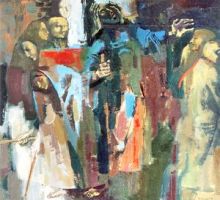Ukrainians celebrated the Freedom Day unofficially on November 22. The holiday, established by president Viktor Yushchenko in 2005 and abolished by his successor Viktor Yanukovych in 2010, was held primarily to celebrate the Orange Revolution events. However, the Ukrainian Freedom Day has much more to it, as freedom itself means more to the Ukrainians than just a revolution. “If the will to be free is to be considered a core European value, we are one of the most European nations,” the historian, political scientist, and the fourth James Mace Prize winner Oleksandr Palii said. Actually, the Ukrainians have yet to rethink the concept of freedom and its importance. Some artists have done it already through their works.
The Freedom Day exhibition, which includes works by about 40 artists from Kyiv, Kharkiv, Odesa and Ternopil, has opened at the Olena Zamostian Gallery of Arts on November 22. “When Yanukovych signed a decree merging the Freedom Day and The Day of Unification, it became clear that it was simply the elimination of this holiday,” the exhibition’s inspirer and organizer, a member of the National Union of Artists of Ukraine Oleksandr Melnyk told The Day. To keep the 2005 initiative alive was one of the aims of the exhibition that is presenting thematic artworks. However, the organizers say the exhibition’s scope is wider than just everyday life during the Orange Revolution. The works on display include paintings by Vasyl Zabashta, Mykola Storozhenko, Vira Barynova-Kuleba, Volodymyr Priadko, Volodymyr Pasyvenko, Oleksandr Oliinyk, Oleksandr Ivakhnenko, and Oles Solovei, ceramics by Halyna Sevruk, sculptures by Mykola Bilyk, Mykhailo Horlovy, and Vasyl Byk, tapestries by Maria and Natalia Lytovchenko, and paper decorations by Vasyl Korchynsky. The exhibition’s context is wide enough to allow Ivan-Valentyn Zadorozhny’s works from the Khata Memorial Arts Museum to be included seamlessly in its program.
“Artists can only create real art when they are free, independent, and uninhibited, that is, free of dogma, independent of government and buyers, and uninhibited in their creative quests,” Melnyk adds. “Ukraine has always had such artists. They were persecuted by the authorities and lived in poverty, but remained faithful to their vocation. It was, actually, the artists’ contribution to our common struggle for freedom.”
It is no accident that the exhibition is hosted by the Kyiv Mohyla Academy. This institution hosted “Ukraine from the Trypillian Culture to the Present as Pictured by Modern Painters,” the first exhibition of historical paintings in Ukraine, in 2004, a month before the presidential campaign started.
The exhibition will run until December 8 at 9 Illinska Street, the Culture and Arts Center of the Kyiv Mohyla Academy, the Olena Zamostian Gallery of Arts. Admission is free.







